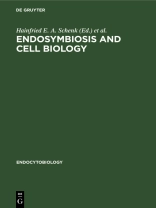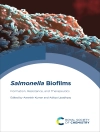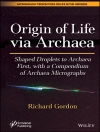Зміст
Frontmatter — PREFACE — WELCOME ADDRESS — CONTENTS — PART I. MORPHOLOGY AND PHYLOGENY OF PROKARYOTES, PROTISTS AND UNICELLULAR ALGAE — An improved method for labelling and sequencing T1-generated RNA-fragments — Macromolecule sequencing in phylogenetic studies: the phylogeny of spherical prokaryotes — Morphology and systematic position of some endocyanomes — Electrophoretic patterns of phycobiliproteins as taxonomic fingerprints of cyanobacteria (and endocyanelles?) — Morphology and phylogeny of flagellated protists — The imprints of ciliate phylogeny revealed by comparative freeze-fracture study of the ciliary membrane — Prokaryote evolution and the symbiotic origin of eukaryotes — PART II. MORPHOLOGICAL AND BIOCHEMICAL ADAPTION OF EUKARYOTES (ALGAE) IN INTER- AND INTRACELLULAR ENDOSYMBIOSIS — Glenodinium foliaceum: a dinof lagellate with an endosymbiont — Carbon metabolism of endosymbiotic algae — The regulation of the algal population size in Paramecium bursaria — Hypothesis: free maltose and cell surface sugars are signals in the infection of Paramecium bursaria by algae — Algal symabionts in larger foraminifera — Growth of the symbiont-bearing foraminifera Amphistegina lessonii d’Orbigny and Heterostegina depres’sa d’Orbiqnv (protozoa) — Symbionts in planktonic foraminifera (protozoa) — Ca deposition, re-mobilization and re-deposition in foraminifera and corals associated with algal endosymbionts (A) — A non essential role of the symbiotic zooxanthellae in the strobilation of Cassiopeia andromeda (scyphozoa, coelenterata) — An ecological view of specificity in algal-invertebrate associations with reference to the associations of Symbiodinium microadriaticum and coelenterates — Intraspecific variation in a zooxanthella — Release of photosynthetically-derived organic carbon from a hermatypic coral, Acropora cf. acuminata — Correlation of the ultrastructure of the cells of solid corals and their symbionts depending on light — Transmission of the algal and bacterial symbionts of green hydra through the host sexual cycle — Phagocytic recognition and the establishment of the Hydra viridis – Chlorella symbiosis — Regulation in the green hydra symbiosis — Sulfur metabolism in the green hydra symbiosis: the incorporation of sulfate-sulfur by symbiotic and aposymbiotic Hydra viridis — Transfer of photosynthate in green hydra — Symbionts involved in phosphate uptake by green hydra — Nutrient competition as a basis for symbiont selection in associations involving Convoluta roscoffensis and Amphiscolops langerhansi — Acquisition of algae by Convoluta roscoffensis — Symbiotic relationships between fungus and alga in basidiolichens — PART III. MORPHOLOGICAL AND BIOCHEMICAL ADAPTION OF PROKARYOTES (BACTERIA, CYANOBACTERIA) IN ENDOCYTOBIOSIS — Euglena gracilis – an eukaryote containing prokaryote type superoxide dismutase and unconjugated pteridines — The hydrogenosome, an H2-producing organelle of anaerobic flagellate protozoa2 — Modulation of polyamine level and biosynthetic enzymes by bacterial endosymbiontes in trypanosomatid protozoa — Effect of a bacterial symbiont on cell division in a ciliate — Aspect of ‘bacteria-ciliates’ symbiosis in the rumen: postulated role of the bacteria in the digestive system of the ciliate — Nucleus-specific symbionts in Paramecium caudatum — Omikron, an essential endosymbiont of Euplotes aediculatus — DNA of omikron — R bodies in Pseudomonas — Electron microscopy of lice symbionts — Ultrastructural data on pseudococcid endosymbionts (homoptera, coccoidea) — Investigations of the light microscopical and ultrastructure of the demeton-S-methyl resistance aphids under consideration of the mycetome symbionts of the Phorodon humuli Sch — Elimination of symbionts of tsetse flies (Glossina M. morsitans W.) by help of specific antibodies — Symbiont-dependent arrhenotokous parthenogenesis in the eukaryotic Xyleborus — Luminescent bacterial endosymbionts in biolum












